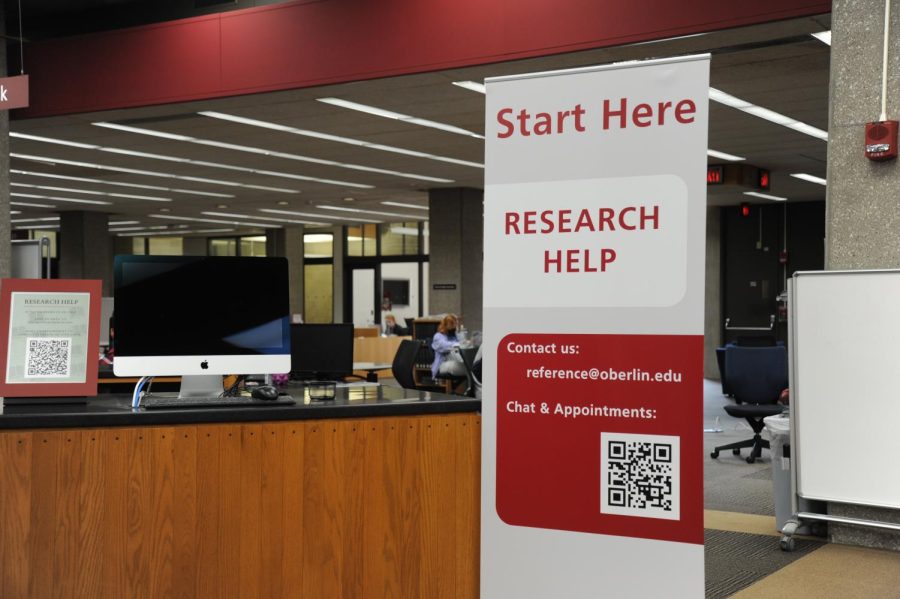Interdisciplinary Study Essential to Liberal Arts Education, Should Be Encouraged
The Research Center, located in Mudd Center, provides students with resources to support their interdisciplinary studies.
At Oberlin and across higher education in general, those studying STEM and those studying humanities rarely branch out toward their disciplinary other. By extension, the practice of glorifying hyper-specialization within institutions is encouraged by capitalism. It’s not uncommon to hear, “I can’t stand STEM classes,” “Keep me away from those humanities majors,” or the rather sad “I think it’s interesting, but I refuse to do math.” In my Creative Writing major, I meet very few fellow students with an interest in math or physics, and conversely, I’ve met a fair number of STEM majors who, despite their commitment to consumption of the arts, have some aversion to taking art classes themselves. We tend to stay on our own side of this particular disciplinary chasm. However, it’s important for arts and humanities majors to take some STEM classes and for STEM majors to take arts and humanities classes. In service of this, STEM classes should work to be more accommodating of people coming in from outside STEM fields, and arts and humanities classes should work to be similarly accommodating.
When I first arrived at Oberlin, I was finishing Everything and More, a book by David Foster Wallace about the history of the mathematical concept of infinity. That book inspired me to take a course in the Mathematics department called Discrete Mathematics, which is, to date, one of the most interesting courses I’ve taken at Oberlin. I did worse in Discrete than I did in any other class that semester — a trend that continued when I took Calculus II later on (making it difficult to justify taking further math classes when faced with my GPA). However, something interesting happened while I was taking calculus: the math I was learning started to seep into my poetry. Calculus deals with integrals, derivatives, and repeated sums, which involve ways of making something smooth, continuous, and unified out of infinitely smaller, jagged pieces. I found deep aesthetic motivation here, and I started thinking about other things as made up of infinite parts coming together into smooth wholes.
In finding inspiration from the sciences, I seek to emulate authors as well. In his collection of short stories, Stories of Your Life and Others, Ted Chiang writes about a fictional proof that one equals two (without sneakily dividing by zero). He uses this proof as a device to destabilize the characters and to explore what happens when a fundamental fact of life is turned on its head. Peter Watts’ science fiction novel Blindsight includes a bibliography at the end, with extensive notes on the world in which the book takes place. Watts uses Blindsight to ask questions about whether or not our conscious awareness of the world is evolutionarily advantageous or even desirable through rigorously exploring all the ways the brain can be fiddled with.
Not everyone is writing about airplanes or dividing by zero, but we are writing in the context of our world, which is rigorously theorized by scientists and mathematicians. While some background is needed to understand everything properly, STEM can sometimes offer writers just the right metaphor or word. Scientists and mathematicians have some hilarious words—quark is one of my favorites.
On the other side of things, STEM majors generally don’t engage with non-scientific writing. As a result, scientific papers tend to be dense, difficult to understand, and clunkily written, making them inaccessible to the general public. Political divisions surrounding climate change and vaccines are both scientific nonissues. The scientific writing on these subjects can be difficult to access and understand, meaning that those without the proper background are left to trust the media and politicians, who themselves may misunderstand the science or spread false information. Practice in writing in narrative and prose can help scientists make their work more accessible. It’s easier to convince a skeptic using a narrative than an appeal to authority or through confusing data. What if there were creative writing courses that focused on scientific nonfiction or popular science writing? What can a literary analysis of the way publishing brings power to certain ideas tell us about patterns of scientific publishing?
It’s not hard to understand why STEM majors don’t frequent poetry classes. They’re difficult to get into, and it takes some work and creativity to connect what they might teach you to your more familiar area of study. Conversely, STEM classes tend to be very technically oriented, with a focus on memorization of concepts that will be important later. Art and humanities majors may not want to spend their time learning concepts that will only be useful in other STEM classes.
Oberlin is a liberal arts school, which means it provides flexibility in what classes students can take outside of their major and when they can declare or change their majors. In general, this freedom aims to give students a broad, multifaceted education. However, in the professional sphere, fixation on one subject is becoming increasingly the norm. We hear stories about math prodigies or pianists who started practicing at younger and younger ages. One story that gets told often in creative writing circles is a writer describing themselves as a child who always loved writing and knew they wanted to be a writer when they grew up. The normative moral here is the successful professionalization of children. We are not writers, just as we are not scientists or athletes. Although these are all roles we play, we cannot and should not mistake ourselves for them. Especially during our short time at Oberlin, we should look to explore new and scary things, stretch ourselves, and grow, and our institution should support that.







